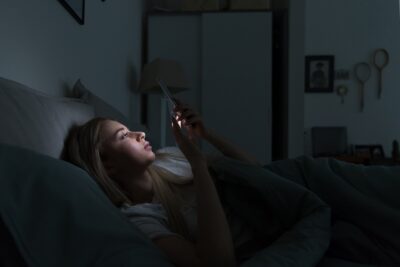Cognitive Behavioral Therapy (CBT) is a psychotherapy-based approach to dealing with health issues that are habit/behavior/cognition-rooted. The goal of CBT is to change the way people think about a real or perceived health problem. Then, it aims to change the behaviors associated with that problem. In most cases, people’s health problems do indeed stem from their behaviors and habits. CBT has been proven to be an efficient treatment method in more than 2,000 scientific studies. Most specialists know and accept its outstanding efficacy in treating insomnia. In this article, we dissect CBTI, Cognitive Behavioral Therapy for Insomnia, taking a closer look at some of its components.
How and Why Does CBT Work?
Why does CBT work the way it does and how exactly does it help you against insomnia?
CBTI (Cognitive Behavioral Therapy for Insomnia) alters sleep-linked cognitions.
Such cognitions are:
- Various beliefs concerning sleep.
- Attributions.
- Expectations (“I need my eight hours of sleep”).
- Attitudes (“I need my eight hours of sleep and anything less I will consider a failure”).
Various set-piece situations make the starting point of CBTI. Such a situation may be the inability to fall asleep quickly. This situation triggers a range of negative emotions in the insomnia sufferer. Anxiety and fear are such emotions and they are incompatible with sleep.
The issue of insomnia is a vicious, self-perpetuating circle. Sleep doctors know its elements relatively well, which is why they can apply CBTI to great effect.
As mentioned, the first element of this circle is a situation. This situation may consist of:
- Emotional arousal (bad emotional states).
- Cognitive arousal (your brain keeps generating thoughts and images).
- Physical arousal (muscle pain, overall malaise, etc).
The situation leads to various attitudes and beliefs. You may:
- Worry excessively about your sleep loss.
- Ponder over its consequences.
- Build up unrealistic expectations.
The next link in the chain is behavioral. As a result of the aforementioned processes, the sufferer develops a series of adaptive habits, such as:
- Time spent in bed while awake (trying to “force” sleep).
- Erratic sleep schedule.
- Daytime sleep (attempting to pay off that “sleep debt”).
- Sleeping pill abuse.
- Poor sleep hygiene and sleep-hindering habits.
Such behaviors draw obvious consequences.
- Fatigue.
- Daytime sleepiness.
- Social discomfort.
- Drop in performance.
- Mood-related problems.
These consequences then tie right back into the situational component of insomnia, thus completing the circle.
This is the mechanism that CBTI disrupts, in several ways. It represents a multi-prong attack on the mentioned emotions, behaviors, and beliefs/attitudes. Every one of the described elements of insomnia is a target for CBTI.
This multi-pronged nature explains its outstanding efficiency.
CBTI Indications
CBTI is effective for every type of insomnia. Its cognitive techniques focus on cognition-related problems, however. Thus, the best candidate for such a treatment is an insomniac with faulty beliefs about sleep. Adding unrealistic expectations to the mix also makes sense.
The only insomniac category that may not respond particularly well to cognitive therapy is the idiopathic one. Such patients may not nurture unrealistic beliefs and expectations about sleep.
Taken together with its other components, CBTI will, however, address most insomnia triggers and promoting factors.
CBTI Contraindications
Given CBTI’s nature, it is hardly surprising that it does not carry any contraindications. That said, it requires the ability to reason as well as some predisposition for introspection. Patients need to be able to see their decisions, emotions, and sleep-related behaviors objectively. They have to be able to question and challenge their beliefs as well.
Everyone capable of that mental exercise is a good candidate for treatment through the cognitive techniques of CBTI.
When we look at the treatment method as a whole, sometimes even people incapable of introspection may respond well. Relaxation and sleep restriction, for instance, may improve sleep for such patients too.
Cognitive Techniques
The procedures sleep therapists use through CBTI are the same ones psychologists use to treat depression and anxiety. Namely:
- Shifting attention.
- Decatastrophizing.
- Reattribution.
- Reappraisal.
Specialists use techniques such as Socratic questioning, guided discovery, and collaborative empiricism to trigger positive changes in their patients. This is a multi-step process.
- The first step is to help patients identify their negative thoughts and feelings about sleep.
- Next, therapists guide their patients to discover the connections between these thoughts, emotions, and the behaviors they trigger.
- Therapists present their patients with evidence concerning these thoughts and their eventual impact on sleep.
- The next step is to substitute these faulty cognitions. Interpreting them correctly is the first step toward their elimination.
- The coup de grace is the identification of the core beliefs which lead to such distorted cognitions. The alteration of these beliefs wraps up the process.
Presenting the mentioned cognitive model to patients is also important. This way, they can thoroughly understand the process.
Patients then move on to the stage of self-monitoring. They ask themselves questions such as “What exactly was I thinking when I was unable to sleep last night?”, “How did I feel at that time?”, etc.
Through self-monitoring, patients can identify a much wider range of dysfunctional thoughts than through therapy alone.
The second stage of the treatment is to encourage patients to view their interpretation of these thoughts as only one of several possible interpretations. Once doubt takes hold, the dysfunctional thoughts lose their power over the insomnia sufferer.
Some patients may believe that their insomnia has a physical/biochemical origin. Attempting to convince such insomniacs of the opposite is futile and counterproductive. Instead, CBTI reveals to them that there are scores more potential causes behind their insomnia.
In some instances, such education is enough in and of itself to convince patients of the erroneous nature of their beliefs.

Stimulus Control
Stimulus control is about influencing the discriminative stimuli linked to sleep onset. In insomniacs, such stimuli promoting the onset of sleep, may not exist. In other cases, strong discriminative stimuli for sleep-hindering activities may be present.
What does that mean in layman’s terms?
If you find yourself repulsed and aggravated by the very idea of bed and bedroom, your sleep-promoting discriminative stimuli have been replaced with sleep-avoiding ones.
If getting into bed prompts you to whip out your phone or laptop and start browsing the internet, your sleep-promoting discriminative stimuli have been replaced with sleep-hindering ones.
What you need is to associate the bed and the bedroom with restful, rejuvenating sleep. Ideally, the mere thought of a bed/bedroom should make you sleepy. This is what stimulus control looks to accomplish. To have you associate the bed with sleep again.
To this end, the treatment method adopts a multi-step approach.
- It introduces the concept of stimulus control to (often skeptical) patients.
- It details the instructions that make up the method.
- It comes up with a plan for patients, detailing what they should do at night.
The gist of stimulus control is that you should only use the bed for sleeping. You should eliminate activities such as eating in bed, reading in bed, worrying in bed, watching TV, and browsing the internet.
Sleep Restriction
Sleep restriction is a CBT method aimed at stimulating the homeostatic sleep drive. This is your natural drive to sleep/get rest when you feel tired.
By restricting sleep, SR increases insomniacs’ propensity for sleep.
The method uses the concept of sleep efficiency. Specialists have defined sleep efficiency as the ratio of time spent in bed and time spent sleeping. The closer this ratio is to 100%, the better the quality of sleep you are getting.
The best candidates for SR are patients whose sleep efficiency is below the 80-85% mark. Therapists manipulate the time-in-bed variable to increase sleep efficiency and limit the time patients spend in bed while awake.

The method entails three major variables:
- The patient’s typical sleep duration.
- The workday wake-up time of the patient.
- The sleep stage/portion of the night is where the best quality sleep occurs.
Based on these variables, sleep specialists come up with a bedtime/wake-up schedule, that limits time in bed while awake, yet leaves intact the portion of the night with the best sleep quality.
The end goal of the method is NOT to increase sleep efficiency to perfection. Rather, it aims to provide the sufferer with good-quality, relaxing, and restful sleep. Once the sleep therapist fine-tunes a sleep schedule that fulfills this goal, he/she asks the patient to make it routine.
Mindfulness
Changing the attitude of the insomniac towards the condition is a key principle of CBTI. This is what specialists have set out to accomplish through mindfulness therapy.
To sum up the goals of the method, mindfulness therapy preaches that:
- Insomnia should not be a burden for the insomniac. It is a mere situation. It is not something that needs fixing.
- Patients do not passively accept the presence of the condition, however. Their decision to be non-reactive is a conscious choice.
- Mindfulness creates room for alternative views on what sleep disturbance is.
Mindfulness combines the benefits of stimulus control, sleep hygiene, and sleep restriction, within a meditative frame.

The main principles of mindfulness are:
- Beginner’s Mind. This mental state lets the patient view every night as a standalone entity. No previous experiences exert any influence upon it.
- Letting go. Patients let go of their attitudes and expectations concerning sleep.
- Non-striving. There is no point in forcing sleep. Just let it unfold on its own.
- Non-judging. Patients do not judge their awake state as something negative. It is just a fact.
- Acceptance. Since you cannot sleep, just get out of bed. Return when you feel sleepy.
- Trust. Your insomnia treatment works. CBTI is a scientifically proven method.
- Patience. Do not expect instant results. Give it time. The results will come.
Relaxation
Relaxation is essential to good sleep. Without being able to relax before sleep, you likely will not be able to fall asleep. There are scores of methods to bring about relaxation.
In the context of CBTI, the principles of relaxation are the following.
- A favorable environment. You need a quiet and cozy bedroom.
- A comfortable position.
- An object on which you can focus.
- An attitude of passivity.
Of these principles, some hardly need explanation. You will not be able to relax in a position of physical discomfort. You will also find it impossible to relax with someone listening to loud music next to you.
The object to dwell upon is a bit more interesting. This object does not have to be a physical one. It is a mere mental device, a figment of your imagination, that draws in and consumes all your attention. Thus, it replaces your daily concerns, sweeping your mind clear of arousing thoughts.
The object of your mental focus should be boring and repetitive.
The passive attitude is the most important component of relaxation. What it means is that you should not compel your mind to focus on relaxation. Let it wander instead. It will revert to the task at hand on its own accord.
Progressive Muscle Relaxation is an accepted relaxation technique.
Sleep Hygiene
Sleep hygiene is perhaps one of the more straightforward components of CBTI.
It covers:
- Lifestyle advice about substance use, diet, and exercise.
- Environmental factors such as lights, sounds, and noises, as well as temperature.
- Bedtime routine recommendations.
Sleep professionals can deliver this treatment method in several ways.
- They may simply hand the patient a sheet of paper containing all their sleep hygiene recommendations.
- They may progressively educate the patient using a question-and-answer approach. Thus, they allow the patient to discover the right answers by him/herself.
- They may adopt a “nit-picking” approach, analyzing the individual sleep hygiene issues of the patient and delivering personalized recommendations.
In the context of CBTI, the basic rules of sleep hygiene work extremely well.
- Do not nap during the day. Such naps will mess up your sleep timing, depth as well as duration.
- Exercise in the late afternoon or early evening. Aerobic exercise has been proven to be a boon for sleep when timed properly. More specifically, it helps deepen sleep.
- Do not use alcohol as a sleep aid. It fragments your sleep and ruins its quality.
- Avoid caffeine for at least six hours before bedtime. This one is self-explanatory.
- Eat a snack one hour before bedtime. Carbohydrates promote sleep. Avoid sweets, however.
- Steer clear of liquids before bedtime. Going to bed with a bladder poised to fill up soon makes for a bad night’s sleep.
- Do not allow your pets into your bed. Their squirming and nighttime activities will awaken you.
- Quit smoking, or do not take up the habit at all. Nicotine is a stimulant.
- Do not be shy to use earplugs to dampen noise.
- Make your sleeping quarters as comfortable and relaxing as possible.
- Stick to a regular sleep schedule.
Conclusion: CBTI
CBTI is a complex and potent treatment method for insomnia. It attacks the condition on multiple fronts and it is very effective. Believe in it and heed your therapist’s recommendations.


